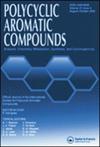Multifunctional Pyrazolo[3,4-d]Pyrimidine Analogs (HCQ-PPs): Design, Synthesis and Anti-SARS-CoV-2 Evaluation
IF 2.6
3区 化学
Q2 CHEMISTRY, ORGANIC
引用次数: 0
Abstract
The novel, highly infectious SARS-CoV-2 virus caused millions of deaths and infections globally. At the same time, the emerged drug repurposing strategy may ultimately not yield a significant clinical benefit. Herein, we designed and synthesized a novel class of pyrazolo[3,4-d]pyrimidines (HCQ-PPs) whose structures were verified by spectral and analytical means as novel anti-SARS-CoV-2 agents. CPE-inhibition assay emerged the 6-((2-hydroxyethyl)aminomethyl) HCQ-PP-1 as the most active analog, exposing about 50% and 29% inhibition compared to remdesivir (88.75% and 70.42% inhibition) at 100 and 10 µM, respectively, indicating the pivotal role of N1, C3 and C4 functionalization. The docking results displayed a unique binding mode of HCQ-PP-1 in the SARS-CoV-2 Mpro binding pocket that could underlie its potential activity with FRED energies of −7.71 comparable to that of remdesivir (-6.71). Its drug-likeness properties met the criteria of Pfizer with an excellent ADMET profile. Therefore, this study presents a novel anti-SARS-CoV-2 lead compound that is worthy of further investigation and activity improvement.
多功能吡唑[3,4-d]嘧啶类似物(HCQ-PPs)的设计、合成及抗sars - cov -2评价
新型高传染性SARS-CoV-2病毒在全球造成数百万人死亡和感染。同时,出现的药物再利用策略可能最终不会产生显著的临床效益。本文设计并合成了一类新型吡唑[3,4-d]嘧啶类化合物(HCQ-PPs),其结构经光谱和分析手段验证为新型抗sars - cov -2药物。cpe抑制实验显示,6-((2-羟乙基)氨基甲基)HCQ-PP-1是活性最高的类似物,在100µM和10µM下,与remdesivir(88.75%和70.42%)相比,HCQ-PP-1的抑制作用分别为50%和29%,表明N1、C3和C4功能化的关键作用。对接结果显示,HCQ-PP-1在SARS-CoV-2 Mpro结合口袋中具有独特的结合模式,这可能是其潜在活性的基础,FRED能量为- 7.71,与remdesivir(-6.71)相当。其药物相似特性符合辉瑞公司的标准,具有出色的ADMET配置文件。因此,本研究提出了一种新的抗sars - cov -2先导化合物,值得进一步研究和提高活性。
本文章由计算机程序翻译,如有差异,请以英文原文为准。
求助全文
约1分钟内获得全文
求助全文
来源期刊

Polycyclic Aromatic Compounds
化学-有机化学
CiteScore
3.70
自引率
20.80%
发文量
412
审稿时长
3 months
期刊介绍:
The purpose of Polycyclic Aromatic Compounds is to provide an international and interdisciplinary forum for all aspects of research related to polycyclic aromatic compounds (PAC). Topics range from fundamental research in chemistry (including synthetic and theoretical chemistry) and physics (including astrophysics), as well as thermodynamics, spectroscopy, analytical methods, and biology to applied studies in environmental science, biochemistry, toxicology, and industry. Polycyclic Aromatic Compounds has an outstanding Editorial Board and offers a rapid and efficient peer review process, as well as a flexible open access policy.
 求助内容:
求助内容: 应助结果提醒方式:
应助结果提醒方式:


